Preservation Through Circulation: Ukraine’s Enduring Statehood and Heritage
Aug 24, 2024
A collaboration between the National Museum of the History of Ukraine in the Second World War ("The War Museum")
and the Smithsonian Institution’s National Museum of American History and National Postal Museum
Coins, banknotes, and stamps are made to circulate. As they travel, they carry evidence of the places they were made and the people who made them. Ukrainian coins, banknotes, and stamps feature national symbols and diverse cultural heritage sites spanning more than a thousand years.
As Russian leaders seek to erase Ukrainian national and cultural identity by actively targeting heritage sites, these small circulating objects have the outsized role of preserving this heritage in pockets, mailboxes, and collections around the globe.
The artifacts in this exhibition represent a unique cross-section of Ukraine’s enduring statehood and heritage. Brought together from museum collections in Ukraine and the United States, they showcase Ukrainian history, diversity, and resilience.
Symbols of Ukrainian Statehood
Symbols of modern Ukrainian statehood can be traced back to the medieval period. The tryzub, or trident, became a symbol of power in Kyiv around the 10th century when Kyiv was the capital of a medieval state called Kyivan Rus’, which covered the majority of Eastern Europe at its greatest extent. Its ruler, Volodymyr I, issued coins with tridents around the year 1000 to reflect and solidify the power of his dynasty. The trident was later adopted as a state symbol by the Ukrainian People’s Republic (UPR) in 1917–1918. Today it is the national emblem of Ukraine and known in the nation’s Constitution as the Sign of the Princely State of Volodymyr the Great.
The blue and yellow colors of the national flag also have medieval roots, in the coat of arms from the city of Lviv and Galicia, the western region of Ukraine, but the modern design is often interpreted as representing blue skies above Ukraine’s bountiful yellow wheat fields. Since the Russian invasion in 2022, individuals, businesses, and governments around the globe have flown the flag in solidarity with Ukraine.
The sunflower has become an unofficial national and global symbol of Ukraine, evoking unharvested fields turned to brutal battlefields amidst the Russian-Ukrainian War. The trident, the national flag, and the sunflower have appeared on a wide range of coins, banknotes, and stamps from the 10th century to the present day. By invoking these symbols, each object records evidence of Ukraine’s long history and longstanding struggle for freedom and sovereignty.
During the 10th and 11th centuries, Kyiv was the capital of a medieval state called Kyivan Rus’. Its ruler, Prince Volodymyr I, issued Kyiv’s first coins around 988 featuring his portrait and emblem—a trident or tryzub—to demonstrate his authority. The coins also reflect Volodymyr’s conversion to Christianity and portray him as a Christian emperor, modeled on Byzantine gold coins of the era. Image Credit: @ZemlyactvoKyiv Following the Russian Revolution of 1917 that led to the Soviet Union’s founding in 1922, the Ukrainian People’s Republic (UPR) declared independence from Russia and issued banknotes to signal its national sovereignty and identity. This 100 Karbovanets note was the first banknote issued by the UPR. It was designed by artist Heorhiy Narbut and features the outline of a trident in the center. Narbut’s artistic decision to include the trident in the note’s design convinced the UPR government to adopt the trident as the state emblem. Object Credit: National Museum of American History This is among the first standard postage stamps issued by the Ukrainian People’s Republic (UPR) in 1918. Due to a shortage of metal to produce coins, the same design circulated as currency. Money-stamps were printed on thicker paper, had perforated edges, and included a note on the back affirming its use like a coin. Designed by Heorhiy Narbut and Anton Sereda, the stamps and currency both prominently featured the new state emblem—the trident—encircled by flowers. As these tiny stamps and “coins” circulated, they helped establish the trident as a national symbol. Object Credit: National Postal MuseumThe Tryzub (Trident)
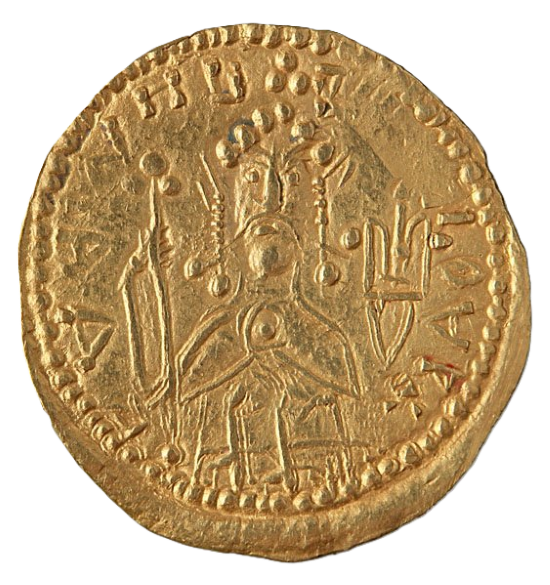


This is the last Ukrainian flag that flew over the Azovstal steel plant in Mariupol during the siege of the city by Russian forces in 2022. In March 2022, Ukrainian forces evacuated it from the besieged industrial epicenter by helicopter along with a group of wounded soldiers. A shell fragment is melted into the flag and recalls Ukraine’s fierce resistance during the lengthy battle for Mariupol. Object Credit: The War Museum Donated to the Museum by the Head of the Defense Intelligence of Ukraine Lieutenant General Kyrylo Budanov. This stamp depicts a tractor flying a Ukrainian flag and pulling a Russian tank against a backdrop of blue and yellow. It recalls the patriotic actions that civilians took to support the Ukrainian army during the first months of the invasion. The subject of the stamp was chosen by popular vote and the title, “Good evening, we are from Ukraine!” signals the lyrics of a song by PROBASS ∆ HARDI that became a ballad of resistance in 2022. Object Credit: National Postal Museum Ukraine issued this commemorative banknote in 2023, one year after the start of the Russian invasion. The front of the note depicts Ukrainian soldiers raising the national flag over a map of Ukraine alongside the flags of allied countries. The back of the note uses the flag’s blue and yellow colors as a backdrop to a scene of bound hands and a gunshot wound (in the form of a poppy), invoking the Russian military’s brutality and human rights abuses against Ukrainians. The note reads, “We remember! We will not forgive! Never.” Object Credit: The War MuseumThe Ukrainian Flag
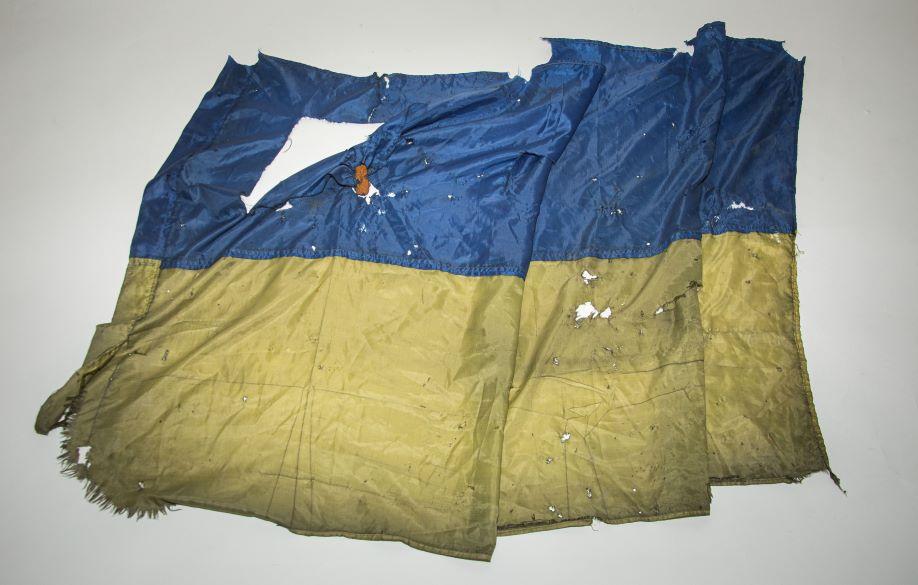

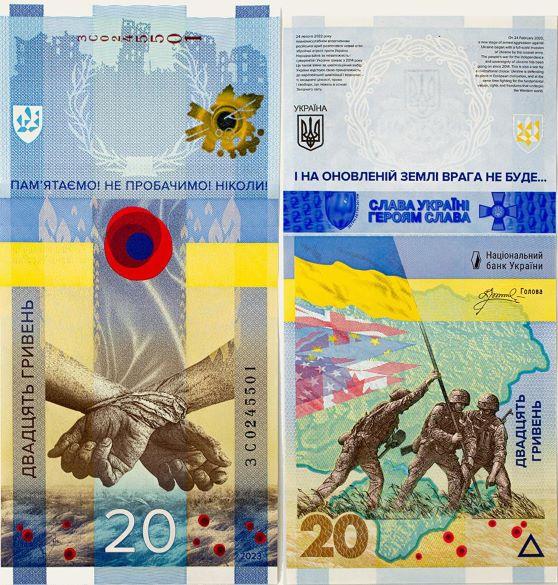
The sunflower has been part of Ukrainian art and identity for many years. During World War II, the Organization of Ukrainian Nationalists (OUN) created the Ukrainian Insurgent Army and fought against German, Soviet, and Polish forces. In exile after the war, the OUN continued the struggle for Ukrainian independence and issued these souvenir stamps, using the sunflower to assert Ukrainian national identity and to raise funds for Ukrainian causes. Today, Ukrainians living in diaspora continue the practice of creating souvenir stamps for the purpose of fundraising for Ukrainian independence. Object Credit: The War Museum This photo shows a fragment of a Russian cluster rocket in an unharvested sunflower field. The Ukrainian War Museum took the photo during an expedition to collect artifacts and evidence of the Russian-Ukrainian War in liberated areas in the Kharkiv region. Unharvested sunflower fields have become a symbol of mourning and loss of life due to Russian attacks since 2014. Image Credit: The War Museum In 2022 Canada reissued this 2011 sunflower stamp to raise funds for Ukraine and demonstrate the longstanding friendship between the two countries. This new version has "Help for Ukraine" written across the top of the stamp; with each booklet sold, $1 is donated to Ukrainians in need. While the original stamp represented Canada's history of growing sunflowers, this new version symbolizes Canada’s support for Ukraine. Object Credit: National Postal MuseumThe Sunflower
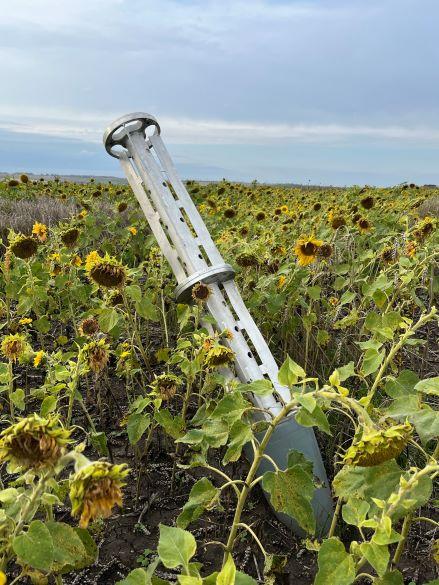
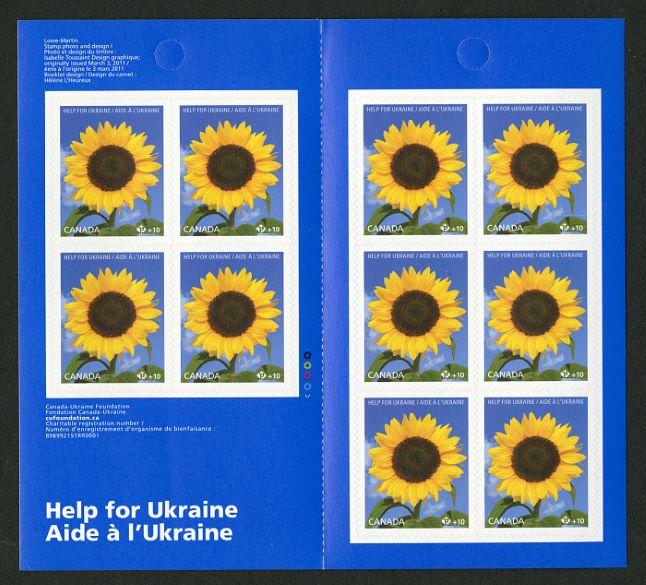
Sites of Ukrainian Cultural Heritage
Ukraine’s distinct cultural heritage is represented by tens of thousands of diverse historic sites across the country. Ancient ruins, medieval palaces and tombs, churches, synagogues, museums, monuments, and libraries provide evidence of the peoples and cultures that have helped shape Ukraine and its modern identity. Many of these historic sites appear on Ukraine’s stamps and banknotes, sharing elements of its national story and contributions to world history through objects seen by millions of people around the globe. As of 2024, Ukraine is home to eight UNESCO World Heritage sites, including three featured on objects in this section. This designation signifies the sites’ universal significance as well as a shared responsibility to protect the sites for future generations. In the context of the Russian-Ukrainian War, these circulating artifacts serve as a powerful reminder of Ukraine’s immovable and irreplaceable sites of cultural heritage, and the importance of protecting and preserving them. Click on a map marker to explore stamps and banknotes with images of historic sites; click on each object image to see the represented site in context. This 2 hryvnia banknote features St. Sophia, Holy Wisdom of God Cathedral in Kyiv. It survives from the Kyivan Rus’ era and is located at the historic center of the powerful medieval state. The cathedral was founded by Kyivan Rus’ leader Volodymyr I shortly after his conversion to Christianity in 988 and was completed by his son Yaroslav I. St. Sophia became an influential religious and cultural center, helping to spread Christianity in Ukraine and across the region. Decorated with stunning original frescoes and mosaics from the 11th century, it is a UNESCO world heritage site. Object Credit: National Museum of American History This 500 karbovanets coupon features the Kyiv Pechersk Lavra, a monastery founded in the 11th century along the Dnipro River in Kyiv. It became a spiritual, cultural, and scientific center for Orthodox Christians. Since the 17th century, the monastery has housed schools that teach the painting of religious icons to share and understand their meaning. After renovations in the 18th century, it became one of the most prominent examples of Cossack Baroque architecture in Ukraine. Today, Kyiv Pechersk Lavra is an active cultural and religious center and a UNESCO World Heritage Site. Object Credit: National Museum of American History This 2 hryvnia banknote features St. Sophia, Holy Wisdom of God Cathedral in Kyiv. It survives from the Kyivan Rus’ era and is located at the historic center of the powerful medieval state. The cathedral was founded by Kyivan Rus’ leader Volodymyr I shortly after his conversion to Christianity in 988 and was completed by his son Yaroslav I. St. Sophia became an influential religious and cultural center, helping to spread Christianity in Ukraine and across the region. Decorated with stunning original frescoes and mosaics from the 11th century, it is a UNESCO world heritage site. Object Credit: National Museum of American History This 500 karbovanets coupon features the Kyiv Pechersk Lavra, a monastery founded in the 11th century along the Dnipro River in Kyiv. It became a spiritual, cultural, and scientific center for Orthodox Christians. Since the 17th century, the monastery has housed schools that teach the painting of religious icons to share and understand their meaning. After renovations in the 18th century, it became one of the most prominent examples of Cossack Baroque architecture in Ukraine. Today, Kyiv Pechersk Lavra is an active cultural and religious center and a UNESCO World Heritage Site. Object Credit: National Museum of American History Hryhoriy Skovoroda was an 18th century Ukrainian philosopher, writer, teacher, and poet dedicated to issues of ethics, morality, and personal freedom. On May 6, 2022, Russian forces deliberately destroyed the Hryhoriy Skovoroda Museum in the Kharkiv region of Ukraine with a missile strike. In response, the Ukrainian Postal Service, Ukrposhta, issued stamps to draw attention to the destruction of the museum and raise funds for its restoration. The stamp is named after Skovoroda’s famous poem collection called The Garden of the Divine Songs. Object Credit: National Postal Museum Hryhoriy Skovoroda was an 18th century Ukrainian philosopher, writer, teacher, and poet dedicated to issues of ethics, morality, and personal freedom. On May 6, 2022, Russian forces deliberately destroyed the Hryhoriy Skovoroda Museum in the Kharkiv region of Ukraine with a missile strike. In response, the Ukrainian Postal Service, Ukrposhta, issued stamps to draw attention to the destruction of the museum and raise funds for its restoration. The stamp is named after Skovoroda’s famous poem collection called The Garden of the Divine Songs. Object Credit: National Postal Museum The 1 hryvnia banknote depicts the ruins of the ancient Greek city of Chersonesus Taurica, located in Sevastopol, Crimea. Greek colonization of southern Ukraine began in the 8th century BCE and left a significant impact on the material culture of Ukraine. Another wave of Greek migration occurred in the 18th century, growing the Greek populations in the Ukrainian Black Sea and Azov regions. Russian attacks on these areas, especially the city of Mariupol, have destroyed sites of Greek heritage in Ukraine, including a museum dedicated to the Ukrainian-Greek artist Arkhip Kuindzhi. Image Credit: National Bank of Ukraine, public domain, via Wikimedia Commons This postage stamp commemorates the history and culture of the Tatar people of Crimea. From the 15th to the 18th century, the Crimean Tatars had their own state called the Crimean Khanate. The tomb depicted in this stamp was the burial place of state leaders called Khans. In 1783 Russia annexed Crimea and, after years of oppression, began deporting the Tatars to Central Asia in 1944, leading to the deaths of many. Nevertheless, the Crimean Tatars are integral to modern Ukraine’s cultural diversity and civic life. Since the 2014 Russian invasion, the Tatars in Crimea again suffer persecution under the Russian occupation. Image Credit: Courtesy of Ukrposhta The 1 hryvnia banknote depicts the ruins of the ancient Greek city of Chersonesus Taurica, located in Sevastopol, Crimea. Greek colonization of southern Ukraine began in the 8th century BCE and left a significant impact on the material culture of Ukraine. Another wave of Greek migration occurred in the 18th century, growing the Greek populations in the Ukrainian Black Sea and Azov regions. Russian attacks on these areas, especially the city of Mariupol, have destroyed sites of Greek heritage in Ukraine, including a museum dedicated to the Ukrainian-Greek artist Arkhip Kuindzhi. Image Credit: National Bank of Ukraine, public domain, via Wikimedia Commons This postage stamp commemorates the history and culture of the Tatar people of Crimea. From the 15th to the 18th century, the Crimean Tatars had their own state called the Crimean Khanate. The tomb depicted in this stamp was the burial place of state leaders called Khans. In 1783 Russia annexed Crimea and, after years of oppression, began deporting the Tatars to Central Asia in 1944, leading to the deaths of many. Nevertheless, the Crimean Tatars are integral to modern Ukraine’s cultural diversity and civic life. Since the 2014 Russian invasion, the Tatars in Crimea again suffer persecution under the Russian occupation. Image Credit: Courtesy of Ukrposhta This stamp features the Zhovkva Synagogue near the city of Lviv. Built during the late 17th century, it was a vibrant center for worship and study for the large Jewish community in the region. It was designed to resemble a fortress so that it would also serve as a place of protection for Jewish people, who faced centuries of persecution. During World War II, the Nazis and their collaborators annihilated nearly all the Jewish people of Zhovkva and attempted to destroy the synagogue. Its outer walls still stand and recall the memory of Jewish people who once lived there, as well as their contributions to Ukraine's national heritage. Image Credit: Courtesy of Ukrposhta This stamp features the Zhovkva Synagogue near the city of Lviv. Built during the late 17th century, it was a vibrant center for worship and study for the large Jewish community in the region. It was designed to resemble a fortress so that it would also serve as a place of protection for Jewish people, who faced centuries of persecution. During World War II, the Nazis and their collaborators annihilated nearly all the Jewish people of Zhovkva and attempted to destroy the synagogue. Its outer walls still stand and recall the memory of Jewish people who once lived there, as well as their contributions to Ukraine's national heritage. Image Credit: Courtesy of Ukrposhta Sites of Ukrainian Cultural Heritage
St. Sophia & Pechersk Lavra
Hryhoriy Skovoroda Museum
Ruins of Chersonesus and the tomb of the Crimean Khans
Zhovkva Synagogue
Exhibition Team:
National Museum of the History of Ukraine in the Second World War:
Yurii Savchuk, Director General
Oksana Yankovenko, Chief Collection Conservator
Volodymyr Tretaik, Head of Research & Collection Management Department
Dmytro Hainetdinov, Head of International Cooperation Department
Maksym Milevskeyi, Collection Conservator
Smithsonian Institution:
Ellen Feingold, Curator of the National Numismatic Collection, National Museum of American History
Jennifer Gloede, Collections Manager of the National Numismatic Collection, National Museum of American History
Rebecca Ben-Atar, Director of Collections, National Postal Museum
Samantha Peterson, Manager of Special Projects, Office of Global Affairs
Header image: Holy Dormition Cathedral of the Kyiv Pechersk Lavra, Kyiv, 2023. Image courtesy of the National Museum of the History of Ukraine in the Second World War
